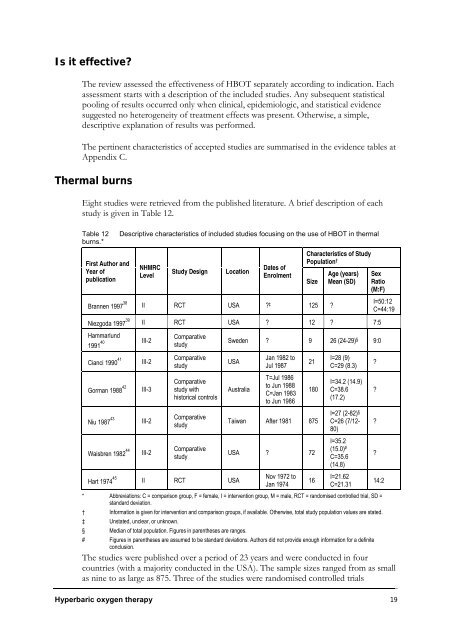Hyperbaric Oxygen Therapy - Hyperbaric Chamber Information ...
Hyperbaric Oxygen Therapy - Hyperbaric Chamber Information ...
Hyperbaric Oxygen Therapy - Hyperbaric Chamber Information ...
Create successful ePaper yourself
Turn your PDF publications into a flip-book with our unique Google optimized e-Paper software.
Is it effective?<br />
The review assessed the effectiveness of HBOT separately according to indication. Each<br />
assessment starts with a description of the included studies. Any subsequent statistical<br />
pooling of results occurred only when clinical, epidemiologic, and statistical evidence<br />
suggested no heterogeneity of treatment effects was present. Otherwise, a simple,<br />
descriptive explanation of results was performed.<br />
The pertinent characteristics of accepted studies are summarised in the evidence tables at<br />
Appendix C.<br />
Thermal burns<br />
Eight studies were retrieved from the published literature. A brief description of each<br />
study is given in Table 12.<br />
Table 12 Descriptive characteristics of included studies focusing on the use of HBOT in thermal<br />
burns.*<br />
First Author and<br />
Year of<br />
publication<br />
Brannen 1997 38<br />
Niezgoda 1997 39<br />
Hammarlund<br />
1991 40<br />
Cianci 1990 41<br />
Gorman 1988 42<br />
Niu 1987 43<br />
Waisbren 1982 44<br />
Hart 1974 45<br />
NHMRC<br />
Level<br />
Study Design Location<br />
Dates of<br />
Enrolment<br />
Characteristics of Study<br />
Population †<br />
<strong>Hyperbaric</strong> oxygen therapy 19<br />
Size<br />
II RCT USA ? ‡ 125 ?<br />
Age (years)<br />
Mean (SD)<br />
II RCT USA ? 12 ? 7:5<br />
III-2<br />
III-2<br />
III-3<br />
III-2<br />
III-2<br />
Comparative<br />
study<br />
Comparative<br />
study<br />
Comparative<br />
study with<br />
historical controls<br />
Comparative<br />
study<br />
Comparative<br />
study<br />
Sex<br />
Ratio<br />
(M:F)<br />
Sweden ? 9 26 (24-29) § 9:0<br />
USA<br />
Australia<br />
II RCT USA<br />
Jan 1982 to<br />
Jul 1987<br />
T=Jul 1986<br />
to Jun 1988<br />
C=Jan 1983<br />
to Jun 1986<br />
21<br />
180<br />
Taiwan After 1981 875<br />
USA ? 72<br />
Nov 1972 to<br />
Jan 1974<br />
16<br />
I=28 (9)<br />
C=29 (8.3)<br />
I=34.2 (14.9)<br />
C=38.6<br />
(17.2)<br />
I=27 (2-82) §<br />
C=26 (7/12-<br />
80)<br />
I=35.2<br />
(15.0) #<br />
C=35.6<br />
(14.8)<br />
I=21.62<br />
C=21.31<br />
I=50:12<br />
C=44:19<br />
* Abbreviations: C = comparison group, F = female, I = intervention group, M = male, RCT = randomised controlled trial, SD =<br />
standard deviation.<br />
† <strong>Information</strong> is given for intervention and comparison groups, if available. Otherwise, total study population values are stated.<br />
‡ Unstated, unclear, or unknown.<br />
§ Median of total population. Figures in parentheses are ranges.<br />
# Figures in parentheses are assumed to be standard deviations. Authors did not provide enough information for a definite<br />
conclusion.<br />
The studies were published over a period of 23 years and were conducted in four<br />
countries (with a majority conducted in the USA). The sample sizes ranged from as small<br />
as nine to as large as 875. Three of the studies were randomised controlled trials<br />
?<br />
?<br />
?<br />
?<br />
14:2



